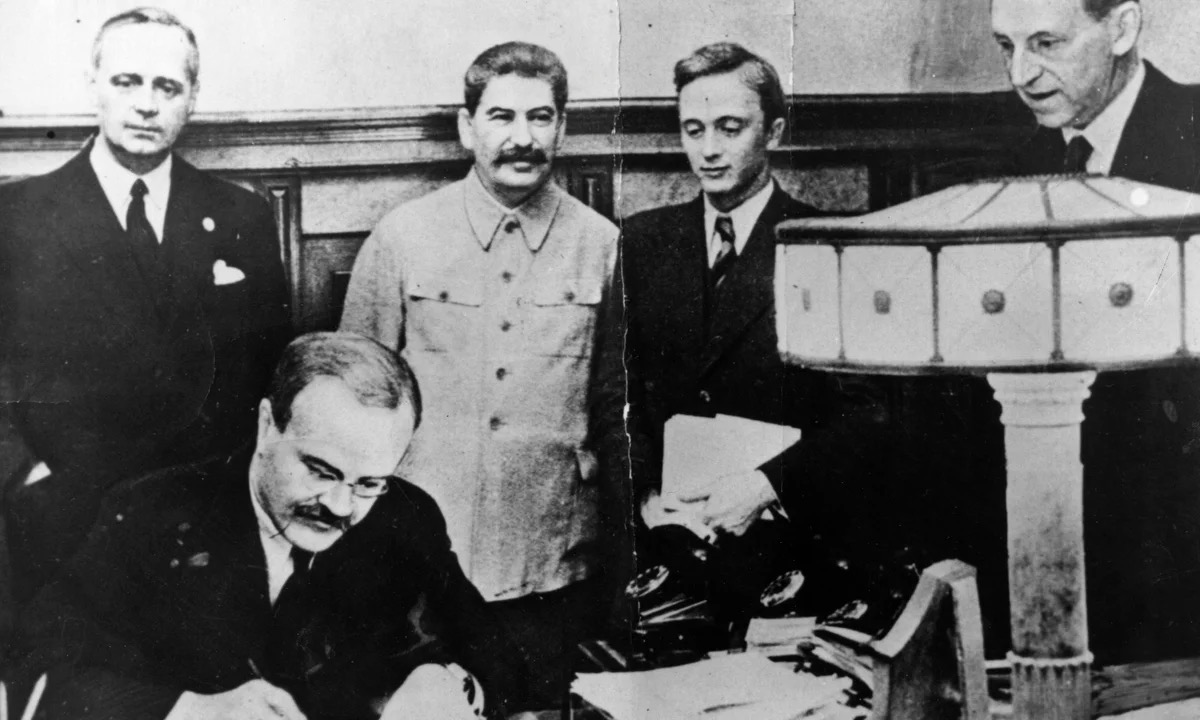
Strategic Shifts and Betrayals: The German-Soviet Nonaggression Pact and the Partition of Eastern Europe
Only a few days before World War II broke out, Germany and the Soviet Union signed the German-Soviet Nonaggression Pact, dividing eastern Europe between German and Soviet areas of influence. In particular, during the Munich Conference in September 1938, the Soviet Union had failed to secure a collective-security pact with Britain and France against Nazi Germany. By early 1939, the Soviet Union was confronted with the prospect of halting German military advance in eastern Europe largely on its own. As a result, they started looking for a shift in strategy. On May 3, 1939, Soviet leader Joseph Stalin dismissed the Jewish proponent of collective security and foreign minister Maksim Litvinov and replaced him with Vyacheslav Molotov, who shortly started talks with Joachim von Ribbentrop of the Nazis.Additionally, the Soviets persisted in talks with Britain and France, but in the end, Stalin decided to negotiate a deal with Germany. He did this in an effort to maintain Soviet peace with Germany and buy time to strengthen the Soviet military apparatus, which had been severely undermined by the 1937 Red Army officer purge. Along with Stalin's own puzzling personal predilection for the Nazis, other factors that contributed to Stalin's decision-making process were the hesitation of the Western democracies to oppose Adolf Hitler.
Hitler desired a nonaggression agreement with the Soviet Union in order for his soldiers to invade Poland almost without resistance from a major state. Germany could then deal with the forces of France and Britain in the west without having to engage the Soviet Union on a second front. The Non Aggression Pact, which was dated August 23 and was signed by Ribbentrop and Molotov in Moscow in Stalin's presence, was the outcome of the German-Soviet discussions. The German-Soviet Nonaggression Pact's basic provisions were as follows: the two nations agreed not to attack one another, either alone or in concert with other powers; not to lend support to any third party that might attack the other party to the pact; to continue consulting one another on issues affecting their shared interests; not to join any coalition of powers that directly or indirectly threatened one of the two parties; and to settle all disputes.
The agreement had a 10-year duration with an automatic 5-year renewal unless either party submitted notice of termination one year prior to its expiration. A secret agreement, also made on August 23, 1939, that partitioned all of eastern Europe into German and Soviet areas of influence was attached to this public pact of nonaggression. Poland would come into the Soviet sphere of control east of the Narew, Vistula, and San rivers. The pact also mentioned the possibility of separating Bessarabia from Romania and included Lithuania, Latvia, Estonia, and Finland to the Soviet sphere of influence. The borders of Lithuania were defined by a covert additional protocol that was signed on September 28, 1939. Additionally, the boundary between Poland and Germany was established, and Bessarabia was placed into the Soviet sphere of influence.
Germany gave up its rights to a piece of Lithuania in exchange for Soviet payment of an amount agreed upon by the two nations in a third secret agreement (signed by Count Friedrich Werner von Schulenberg and Molotov on January 10, 1941). There was outrage at the official German-Soviet Nonaggression Pact in the capitals of Britain and France. On September 17, 1939, Soviet forces invaded Poland from the east, meeting the advancing Germans in Brest-Litovsk two days after Germany invaded Poland from the west on September 1, 1939. On September 29, Poland was divided, and at that time the border between German and Soviet territory was shifted to the east, to the Bug River, favoring Germany (i.e., the current Polish-Soviet frontier).
Soon after, in order to create a protective barrier against further German assault in the east, the Soviets worked to expand their sphere of influence. As a result, on November 30, the Soviet Union attacked Finland, and in March 1940, it was compelled to cede the Isthmus of Karelia and make other concessions. In August 1940, the Soviet Union conquered the Baltic republics of Latvia, Lithuania, and Estonia and established them as Soviet republics. On June 22, 1941, when Nazi Germany unexpectedly launched Operation Barbarossa against the Soviet Union after taking over most of western and central Europe, the Nonaggression Pact was rendered obsolete. Following the end of World War II, the Soviet Union created borders with Poland and Romania that approximately correspond to those set forth by the Nonaggression Pact in 1939–1941. Because they were seen as proof of its forced takeover of the Baltic republics, the Soviet Union denied the existence of the secret protocols until 1989. Although Soviet officials were initially opposed to reestablishing pre war borders, the changes taking place inside the Soviet Union in the early 1990s made it nearly impossible for them to oppose the Baltic nations' declarations of independence in 1991.
The Nazi-Soviet Non-Aggression Pact prevented the Soviet Union from fighting alongside Germany in this way, enabling Germany to successfully defend its borders from a two-front conflict. Until Germany's surprise attack and invasion of the Soviet Union on June 22, 1941, the Nazis and the Soviets upheld the conditions of the protocol and the pact. The Anglo-Soviet Mutual Assistance Pact was signed into force on July 12 after Stalin informed the Russian people via radio on July 3 that he had dissolved the non-aggression pact and declared war on Germany.
Sources Cited
United States Holocaust Memorial Museum, United States Holocaust Memorial Museum, https://encyclopedia.ushmm.org... Editors. “Molotov-Ribbentrop Pact.” History.com, A&E Television Networks, 9 Nov. 2009, https://www.history.com/topics/world-war-ii/molotov-ribbentrop-pact.
Post a comment